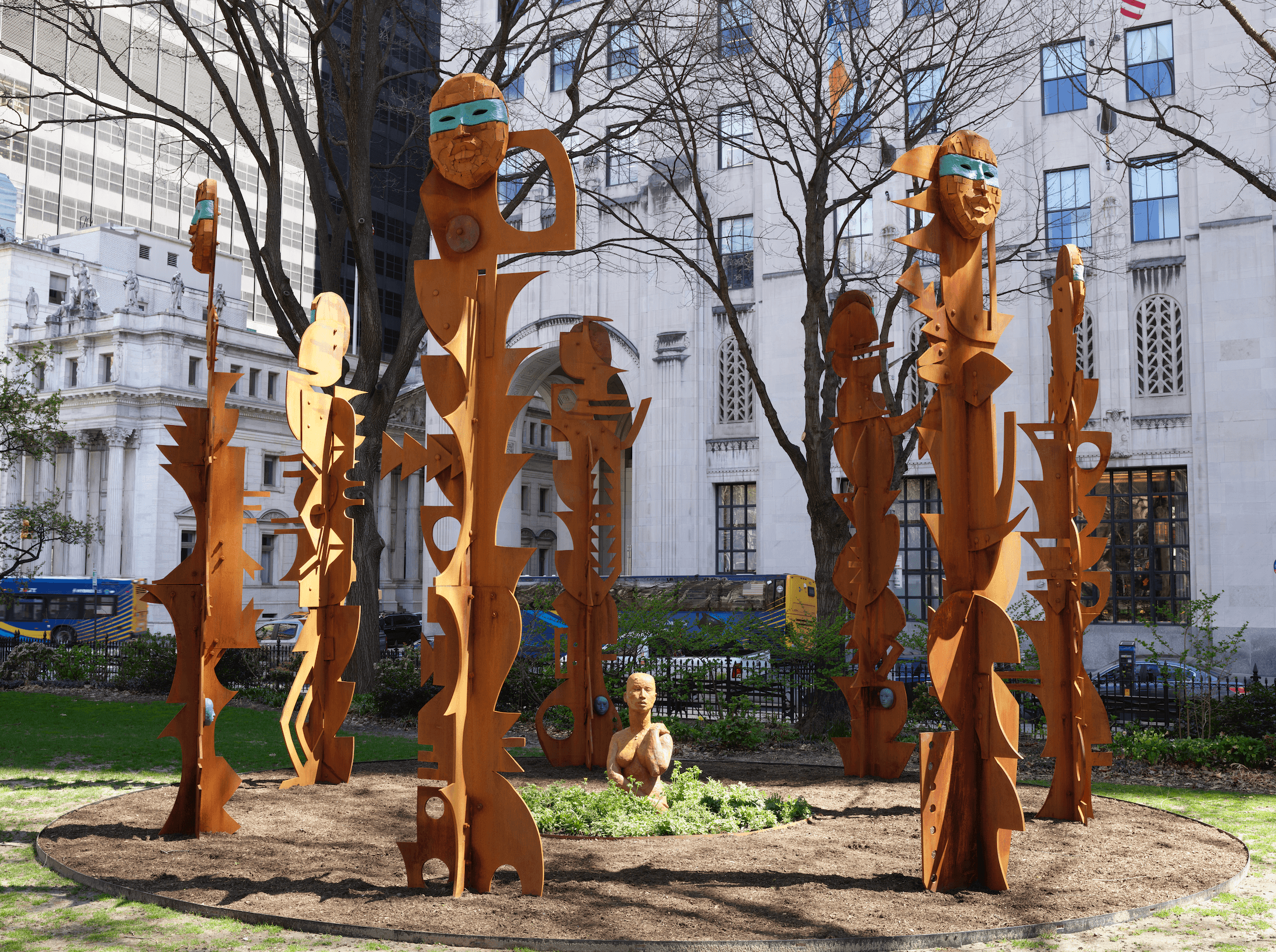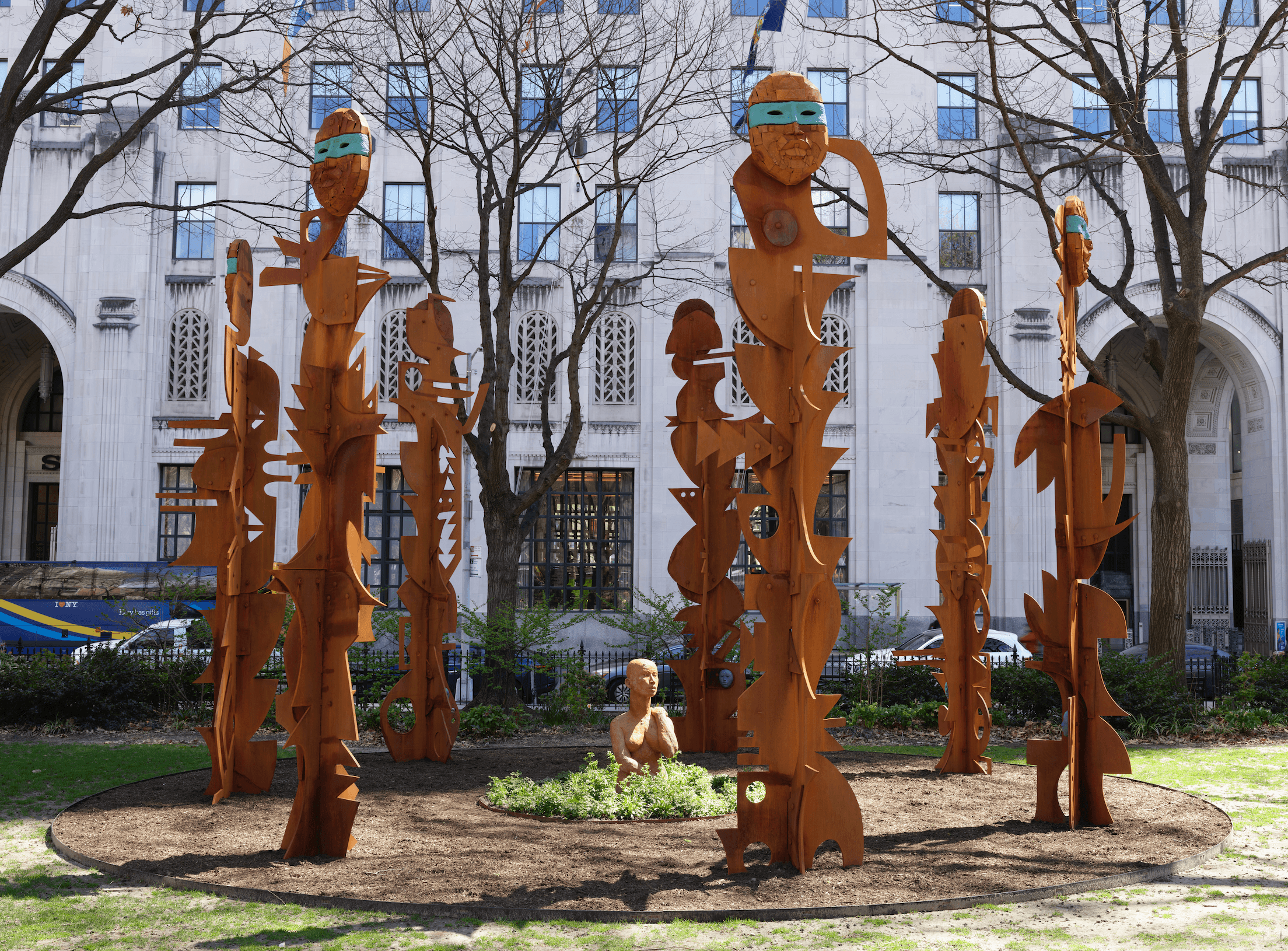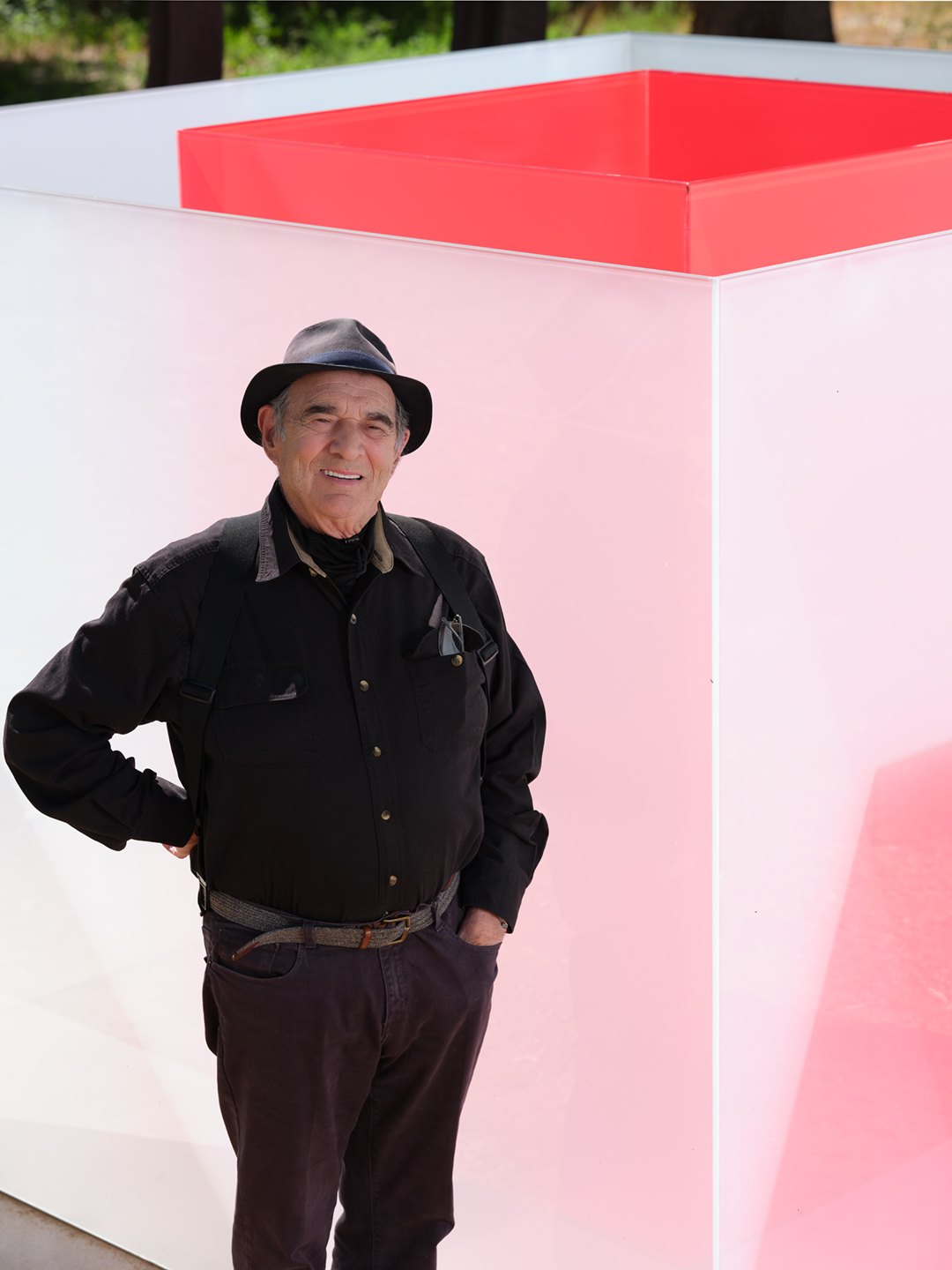This site uses cookies – Learn more.
Rose B. Simpson: “Seed”

Rose B. Simpson: “Seed”
Rose B. Simpson: “Seed”

-
Exhibition CatalogueExhibition Catalogue: "Seed"
-
Press Release
This newly commissioned public art exhibition by Rose B. Simpson is on view simultaneously in Madison Square Park and Inwood Hill Park. Seed is part of the milestone twentieth anniversary of Madison Square Park Conservancy’s art program and is the Conservancy’s first collaboration with another New York City public park. Throughout the run of the exhibition, free public programs will be held with Simpson, artists, neighbors, and Native and area cultural leaders.
Simpson and other artists of her generation are resetting long-entrenched art historical interpretation around the soaring capacity of figuration. Seed is a formidable platform for this reassessment. The artist creates sentinels in weathered steel and bronze that lead with angularity and durability; industrial bolts fasten masks forged in bronze to sections cut from ten-foot-long steel sheets. But there is implicit tension within: Simpson constructs planar compositions that at only three-quarters of an inch deep have an exquisite fragility, like that of a towering paper doll flattened over generations and held in place by a folded steel stand. She shapes symbolism in each sculpture, where the Native past is enduring and resonant. The sentinels seem to have an acute understanding of their role as contemporary figures.
In Madison Square Park, seven eighteen-foot-high sentinels convene in a circle supporting and nurturing a female form who emerges from the earth. In Inwood Hill Park, one sculpture faces the ancient wood in acknowledgment of Native histories deeply connected to the land; the other looks outward to the Hudson River, part of a trade route that brought settlers who worked to obliterate Native people and practices beginning in the 1600s.
The figures in Seed are in the present while anticipating the future from bronze masks patinated in turquoise. The faces looking in are youth; those gazing outward are protectors. They all summon layers of narratives, personal and collective human experiences that have seeded Simpson’s life and art. She refers to visual languages, reflecting her training as a contemporary artist and as a Native artist building fortitude through the assembled group. Simpson’s work channels the vision of an artist raised in Santa Clara Pueblo in New Mexico and is installed in two public parks in Lenapehoking, the homelands of the Lenape people. Her sentinels are androgynous; there is fluidity in their bearing.
The artist recently described the significance of installing Seed in two sites in Manhattan:
While I am there with my work, I have the opportunity to guide through reminders. Maybe my work is about the displaced Indigenous residents who had thousands of years communing with that ground—a heuristic relationship that shaped their culture. Maybe it’s about the act of being in that space, gendered. Maybe it’s about the feeling of communing in a public space, about safety, about the feeling of anonymity that comes from an immense crowd, the clench of protective identity and the need to exhale.
Simpson’s art responds to present-day life and the parklands we treasure and occupy. Visitors to Madison Square Park and Inwood Hill Park will learn about her work, ancestral and contemporary lands, and Native histories through these outdoor exhibitions.
See Seed in the press:
- Art Daily
- City Life Org
- Family Style
- GothamToGo
- Hyperallergic
- Red Financiera
- Surface Mag
- Tourism Quest
- Travel and Tour World
- The Art Newspaper
ARTIST
Simpson’s practice has been nurtured through Indigenous tradition and the multigenerational, matrilineal succession of artists working with clay. Artists from Santa Clara Pueblo are distinguished for their clay work and pottery, often blackware and redware. Simpson’s sculptures range from intimate pieces to outsize standing figures, monumental forms that impart both a spiritual and an earthly resonance. Her innovative techniques and materials connect tradition to contemporary experience.
MADISON SQUARE PARK CONSERVANCY
Since 2004, Madison Square Park Conservancy has commissioned and presented premier projects by visionary artists ranging in practice and media. This year, the art program celebrates its twentieth anniversary with innovative exhibitions, a comprehensive publication, scholarly and exultant programs, and outreach to new communities.
Madison Square Park Conservancy is responsible for raising 100 percent of the funds necessary to operate the park, including its dynamic public art program, vibrant horticulture, maintenance, sanitation, security, and free cultural programs for park visitors.
-
About the artistRose B. Simpson (Santa Clara Pueblo, New Mexico, born 1983) received an MFA from Rhode Island School of Design and an MA in creative writing from the Institute of American Indian Arts. Her work is included in the collections of the Benton Museum of Art at Pomona College; Denver Art Museum; Solomon R. Guggenheim Museum, Metropolitan Museum of Art, and Whitney Museum of American Art, New York; Hirshhorn Museum and Sculpture Garden, Washington, D.C.; Institute of Contemporary Art and Museum of Fine Arts, Boston; Los Angeles County Museum of Art; Museum of Contemporary Art Chicago; Nevada Museum of Art; Pennsylvania Academy of Fine Arts, Philadelphia; Portland Art Museum, Maine; Princeton University Art Museum; San Francisco Museum of Modern Art; and Wheelwright Museum of the American Indian, Santa Fe. Her work is also featured in the 2024 Whitney Biennial. She recently received a prestigious Ruth Award through the Ruth Foundation for the Arts. In 2023, Simpson was appointed to the Board of Trustees of the Institute of American Indian Arts by President Biden. The artist lives and works in Santa Clara Pueblo, New Mexico.
-
About the artistRose B. Simpson (Santa Clara Pueblo, New Mexico, born 1983) received an MFA from Rhode Island School of Design and an MA in creative writing from the Institute of American Indian Arts. Her work is included in the collections of the Benton Museum of Art at Pomona College; Denver Art Museum; Solomon R. Guggenheim Museum, Metropolitan Museum of Art, and Whitney Museum of American Art, New York; Hirshhorn Museum and Sculpture Garden, Washington, D.C.; Institute of Contemporary Art and Museum of Fine Arts, Boston; Los Angeles County Museum of Art; Museum of Contemporary Art Chicago; Nevada Museum of Art; Pennsylvania Academy of Fine Arts, Philadelphia; Portland Art Museum, Maine; Princeton University Art Museum; San Francisco Museum of Modern Art; and Wheelwright Museum of the American Indian, Santa Fe. Her work is also featured in the 2024 Whitney Biennial. She recently received a prestigious Ruth Award through the Ruth Foundation for the Arts. In 2023, Simpson was appointed to the Board of Trustees of the Institute of American Indian Arts by President Biden. The artist lives and works in Santa Clara Pueblo, New Mexico.
This newly commissioned public art exhibition by Rose B. Simpson is on view simultaneously in Madison Square Park and Inwood Hill Park. Seed is part of the milestone twentieth anniversary of Madison Square Park Conservancy’s art program and is the Conservancy’s first collaboration with another New York City public park. Throughout the run of the exhibition, free public programs will be held with Simpson, artists, neighbors, and Native and area cultural leaders.
Simpson and other artists of her generation are resetting long-entrenched art historical interpretation around the soaring capacity of figuration. Seed is a formidable platform for this reassessment. The artist creates sentinels in weathered steel and bronze that lead with angularity and durability; industrial bolts fasten masks forged in bronze to sections cut from ten-foot-long steel sheets. But there is implicit tension within: Simpson constructs planar compositions that at only three-quarters of an inch deep have an exquisite fragility, like that of a towering paper doll flattened over generations and held in place by a folded steel stand. She shapes symbolism in each sculpture, where the Native past is enduring and resonant. The sentinels seem to have an acute understanding of their role as contemporary figures.
In Madison Square Park, seven eighteen-foot-high sentinels convene in a circle supporting and nurturing a female form who emerges from the earth. In Inwood Hill Park, one sculpture faces the ancient wood in acknowledgment of Native histories deeply connected to the land; the other looks outward to the Hudson River, part of a trade route that brought settlers who worked to obliterate Native people and practices beginning in the 1600s.
The figures in Seed are in the present while anticipating the future from bronze masks patinated in turquoise. The faces looking in are youth; those gazing outward are protectors. They all summon layers of narratives, personal and collective human experiences that have seeded Simpson’s life and art. She refers to visual languages, reflecting her training as a contemporary artist and as a Native artist building fortitude through the assembled group. Simpson’s work channels the vision of an artist raised in Santa Clara Pueblo in New Mexico and is installed in two public parks in Lenapehoking, the homelands of the Lenape people. Her sentinels are androgynous; there is fluidity in their bearing.
The artist recently described the significance of installing Seed in two sites in Manhattan:
While I am there with my work, I have the opportunity to guide through reminders. Maybe my work is about the displaced Indigenous residents who had thousands of years communing with that ground—a heuristic relationship that shaped their culture. Maybe it’s about the act of being in that space, gendered. Maybe it’s about the feeling of communing in a public space, about safety, about the feeling of anonymity that comes from an immense crowd, the clench of protective identity and the need to exhale.
Simpson’s art responds to present-day life and the parklands we treasure and occupy. Visitors to Madison Square Park and Inwood Hill Park will learn about her work, ancestral and contemporary lands, and Native histories through these outdoor exhibitions.
See Seed in the press:
- Art Daily
- City Life Org
- Family Style
- GothamToGo
- Hyperallergic
- Red Financiera
- Surface Mag
- Tourism Quest
- Travel and Tour World
- The Art Newspaper
ARTIST
Simpson’s practice has been nurtured through Indigenous tradition and the multigenerational, matrilineal succession of artists working with clay. Artists from Santa Clara Pueblo are distinguished for their clay work and pottery, often blackware and redware. Simpson’s sculptures range from intimate pieces to outsize standing figures, monumental forms that impart both a spiritual and an earthly resonance. Her innovative techniques and materials connect tradition to contemporary experience.
MADISON SQUARE PARK CONSERVANCY
Since 2004, Madison Square Park Conservancy has commissioned and presented premier projects by visionary artists ranging in practice and media. This year, the art program celebrates its twentieth anniversary with innovative exhibitions, a comprehensive publication, scholarly and exultant programs, and outreach to new communities.
Madison Square Park Conservancy is responsible for raising 100 percent of the funds necessary to operate the park, including its dynamic public art program, vibrant horticulture, maintenance, sanitation, security, and free cultural programs for park visitors.
-
About the artistRose B. Simpson (Santa Clara Pueblo, New Mexico, born 1983) received an MFA from Rhode Island School of Design and an MA in creative writing from the Institute of American Indian Arts. Her work is included in the collections of the Benton Museum of Art at Pomona College; Denver Art Museum; Solomon R. Guggenheim Museum, Metropolitan Museum of Art, and Whitney Museum of American Art, New York; Hirshhorn Museum and Sculpture Garden, Washington, D.C.; Institute of Contemporary Art and Museum of Fine Arts, Boston; Los Angeles County Museum of Art; Museum of Contemporary Art Chicago; Nevada Museum of Art; Pennsylvania Academy of Fine Arts, Philadelphia; Portland Art Museum, Maine; Princeton University Art Museum; San Francisco Museum of Modern Art; and Wheelwright Museum of the American Indian, Santa Fe. Her work is also featured in the 2024 Whitney Biennial. She recently received a prestigious Ruth Award through the Ruth Foundation for the Arts. In 2023, Simpson was appointed to the Board of Trustees of the Institute of American Indian Arts by President Biden. The artist lives and works in Santa Clara Pueblo, New Mexico.
-
Exhibition CatalogueExhibition Catalogue: "Seed"
-
Press Release
-
About the artistRose B. Simpson (Santa Clara Pueblo, New Mexico, born 1983) received an MFA from Rhode Island School of Design and an MA in creative writing from the Institute of American Indian Arts. Her work is included in the collections of the Benton Museum of Art at Pomona College; Denver Art Museum; Solomon R. Guggenheim Museum, Metropolitan Museum of Art, and Whitney Museum of American Art, New York; Hirshhorn Museum and Sculpture Garden, Washington, D.C.; Institute of Contemporary Art and Museum of Fine Arts, Boston; Los Angeles County Museum of Art; Museum of Contemporary Art Chicago; Nevada Museum of Art; Pennsylvania Academy of Fine Arts, Philadelphia; Portland Art Museum, Maine; Princeton University Art Museum; San Francisco Museum of Modern Art; and Wheelwright Museum of the American Indian, Santa Fe. Her work is also featured in the 2024 Whitney Biennial. She recently received a prestigious Ruth Award through the Ruth Foundation for the Arts. In 2023, Simpson was appointed to the Board of Trustees of the Institute of American Indian Arts by President Biden. The artist lives and works in Santa Clara Pueblo, New Mexico.
Exhibition Support
Projects and initiatives for the twentieth anniversary of Madison Square Park Conservancy’s art program in 2024 are funded by the following generous supporters.
LEADERSHIP SUPPORT
Sasha C. Bass
Bloomberg Philanthropies
Jacques and Natasha Gelman Foundation
Girlfriend Fund
Hauser & Wirth
Henry Luce Foundation
Mellon Foundation
New York City Department of Cultural Affairs
The Ruth Stanton Foundation
Terra Foundation for American Art
Tiffany & Co.
MAJOR SUPPORT
Anonymous
The Deborah Buck Foundation
Bridgitt and Bruce Evans
Ford Foundation
Helen Frankenthaler Foundation
Meredith Grossman and Lee Kruter
Agnes Gund
Michael Kahn
KC Fabrications, Inc.
Matthew Marks Gallery
National Endowment for the Arts
New York State Council on the Arts
Ronald A. Pizzuti
Lenore G. Tawney Foundation
Thornton Tomasetti
UAP/Art Makers
VIA Art Fund
SUBSTANTIAL SUPPORT
Anonymous
Bunny and Charles Burson
Carmel Barasch Family Collection / Morris A. Hazan Family Foundation
Charina Endowment Fund
Martin Friedman Fund
Sol LeWitt Fund for Artist Work
Madison Square Park Conservancy Art Council
Anthony Meier Fine Arts
Audrey and Danny Meyer
The Scintilla Foundation
Jack Shainman Gallery
Jessica Silverman
Vanessa Tranquilli
ADDITIONAL SUPPORT
The Blue Rider Group at Morgan Stanley
400 Park Avenue South
Gagosian
Becky Gochman
Marian Goodman Gallery
Gray Chicago
Francis J. Greenburger
The Helis Foundation
Jodi and Hal Hess
The James Howell Foundation
The Imperfect Family Foundation
Lisson Gallery
Jane Richards
Jeff Romley
Angelica Semmelbauer
Leon Polk Smith Foundation
Fern and Lenard Tessler
The Andy Warhol Foundation for the Visual Arts
Phillip Y. Zhang

























